 Our Founders
Our Founders
FRANCISCAN SISTERS OF GLASGOW
The history of the Immaculate Conception Academy is inextricably tied to the establishment of the Franciscan Sisters of Glasgow in Jamaica in November 1857, by Mother Veronica Cordier, Sr. Paula Charlet, Sr. M. de Sales O'Neill and Sr. Philomena Dalle. These four women responded to the request of the Very Reverend James Dupeyron S.J., then Vicar Apostolic of Jamaica, and Fr. Joseph Howell S.J. to found a Franciscan Community in Jamaica.
Mother Veronica, who was only thirty-six when she arrived in Jamaica, was also the foundress of the Franciscan Sisters of Glasgow, having previously journeyed to Glasgow from the Monastery of Our Lady of the Angels in Tourcoing, France in 1847. Thus, the historical roots of the foundation of the Immaculate Conception Academy in Jamaica can be traced across the globe to Scotland and France. According to the Franciscan Centenary 1857 to 1957, the Franciscan Sisters of Glasgow arrived in Jamaica with a mere "2/6" (two shillings and sixpence) in their possession. Two shillings and sixpence amounted to thirty pence or, in terms of dollars and cents, approximately twenty-five cents.
However, very soon after their arrival, the Roman Catholic clergy and laity provided the Sisters with monetary support and accommodation. Henry Vendryes, a prominent member of the Catholic community in Jamaica made his house on East Queen Street available to the Sisters. It was at East Queen Street that the Sisters opened the Immaculate Conception Academy, as a boarding school and a day school for girls. The Gaiety Theatre was later housed in these same premises.
FRANCISAN SISTERS OF ALLEGANY
The Franciscan Sisters of Allegany
When the Franciscan Sisters of Glasgow were no longer able to continue sending sisters to Jamaica, their vision and work in the field of education was undertaken by the Third Order Regular of St. Francis of Allegany, New York (the "Franciscan Sisters of Allegany" ). In 1879, Sr. Mary Veronica Murphy, Sr. Mary Raphael McCauliff, and Sr. Mary Dominica Enright, answered the call of the Very Reverend Thomas Porter, then Vicar Apostolic of Jamaica and sailed to Kingston on the banana boat named "Clarabelle."
According to the Novena of Decades of the Third Order Regular of St. Francis of Allegany, New York, these pioneering women became the first of their Order to leave America for work in another country" and the Franciscan Sisters of Allegany, the "first American Community to go on a foreign mission. "These sisters left America when their community was only twenty years old.
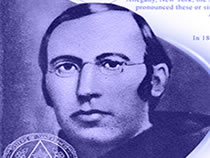
You shall no longer be known as Mary Jane Todd, but as Sister Mary Joseph. This time is April 25, 1859; the place, the chapel of St. Bonaventure College Allegany, New York; the speaker, Reverend Pamphilo da Magliano, O.F.M., who pronounced these or similar words to the first member of the new Community of Sisters being established by him in a small corner of western New York State.
In 1854, Bishop John Timon, the first Bishop of the Diocese of Bufafalo, journeyed to Rome to be present when His Holiness, Pius 1X proclaimed the Dogma of Immaculate Conception. Before leaving the State, Bishop Timon had determined to ask the Minister General of the Franciscan Fathers to send him Friars to labor in his newly formed Diocese. The result of the Bishop's determination was the coming in 1855 of Father Pamphilo and three companions.
They first established themselves in Ellicottville, New York, but soon took up residence in Allegany on the tract of land given them by Nicholas Devereux.
Almost immediately, Father Pamphilo set about the business of establishing St. Bonaventure College for the education of young men. His time was much taken up with plans, buildings, fund-raising and more important, the guiding and training of the members of his community of whom he was the superior.
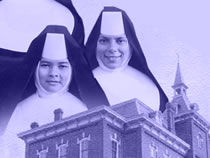
Inspite of all this , he did not forget the remainder of his dream, the establishing of an institution for the education of young women. Just at this time, too, in the city of Philadelphia, were two young Irish women, Mary Jane Todd and Ellen O'Fallon, who desired to serve God through service to their fellowmen. Hearing of the Franscicans in Allegany they decided to go there and make known their aspirations.
Mary Jane came first with Sister Michael McFall of the Glen Riddle Fransciscans. She presented herself to Father Pamphilo and shortly thereafter the ceremony of her clothing and her name-giving as mentioned above took place. Two months later in June, Ellen O'Fallen joined Sr. Michael and Sister Joseph. Father Pamphilo received her also and gave her the name of Sister Bridget
It was in the Fall of this same year that a third member joined the group in Allegany. Father Pamphilo had met Mary Anne O'Neil while visiting in Fort Lee, New Jersey. He was immediately impressed by the qualities of this fifteen year old girl and upon questioning her learned from her own lips that she wanted to become a Sister "when I am old." Father Pammphilo explained to her that waiting until she was old was a lack of generosity to God.
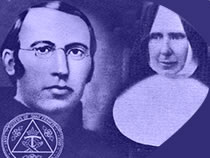
It did not take Mary Anne long to realize this truth and after overcoming the opposition of her parents, who thought her too young, she found her way to Allegany. A third time the college chapel was the scene of a Reception Ceremony. At its conclusion, Mary Anne O'Neil came forth clothed in a brown Franciscan habit and bore the name, Sister Mary Teresa. God's plan was in the fulfilling this 8th day of December 1859 and a long future was to know its effects.
The small Community settled down under the guidance of Sister Michael who stayed with them three years to prepare and train them for their lives as Fransciscans. Father Pamphilo was never far away and he and Father Michael Raybaudi, in spite of their many arduous duties, were ever watchful and solicitous of the Sisters.
For the first few years Father Pamphilo appointed the Superiors of St. Elizabeth Convent. Then in July 1865 all the Sisters assembled in Chapter to vote for the Reverend Mother. Their choice fell upon Mother Teresa O'Neill, a young woman of twenty-one years, to lead the newly founded, growing Community, to give it permanency and stability and to guide its growth and to expand the scope of its work. Mother Teresa was to act in the capacity of Reverend Mother, except for four interim years, until her death in May 1926.
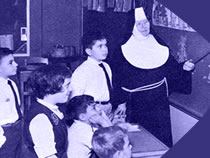
Expansion now faced the small community as a request for Sisters came from Winsted, Connecticut. The reverend Leo Saracena, O.F.M. was pastor in Winsted and wished to have Sisters to teach in his parish school. A call for help from the Friars was not to be treated lightly by Mother Teresa. Consequently, two sisters were sent to establish St. Margaret' School. From Allegany to Winsted was a momentous journey in 1865 and its undertaking must have required great faith and courage. Neither Mother Teresa nor her spiritual daughters lacked either quality, so the journey was made and a parochial school established in Winsted.
Once more in the first year of term as Reverend Mother the Friars appealed to Mother Teresa for Sisters. The appeal this time came for a school in St. Patrick' Parish, Buffalo. At St. Clare' Convent, as they had at St. Margaret' in Winsted, the Sisters opened a private academy for young ladies. Poverty and hardships were experienced in both of these missions but thoughtful priests and generous appreciative people lightened the burdens to make labor in His vineyard a thing of joy and love.
The Allegany Community was to suffer a great loss when their beloved founder, Father Pamphilo, was recalled to Rome by his superiors in the Fall of 1867. At first it was not understood that Father Pamphilo would not return but as time passed and no word of his returning was received, all came to realize that he was in Italy to stay.
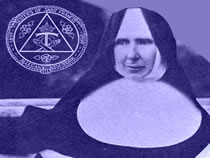
The Sisters missed this humble Friar, who founded them, taught them Franciscan spiritually, guided them through uncertain days, kept their accounts and procured for them an approved Rule. Their prayers were with him always, and even now, almost one and a half centuries later, the Sisters of the community he established still honor him daily in their prayers.
But nothing must stop God's work and Mother Teresa was not one to let personal grief interfere with their duties. Step by Step, day by day, she was nurturing the seed that has been sown, preparing her charges to be ready for the Apostolate. A group was ready when a few years later the Fransiscan Fathers again sent out their call.
This time, Sisters were sent to New York City to teach in St. Anthony's the first Italian parish in America. The goods of this world were scarce in this mission as in the others but hearts were open and generous and the Sisters shared their meager resources with two Italian sisters, Mother Maddalena and Sister Maria Costanza, who were the foundresses of the Poor Clares in America. Now an entirely new venture was considered by Mother Teresa. In 1878, her Sisters were to go to the foreign missions. Three of them were to set sail from New York, spend weeks on board ship and travel miles over stormy ocean to reach their destination, Jamaica in the British West Indies.
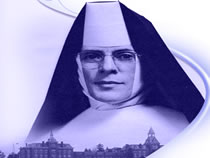
Here, they would join with Franciscan Sisters from Scotland, who had established a boarding and day school for girls, which they named "The Immaculate Conception Academy. "

